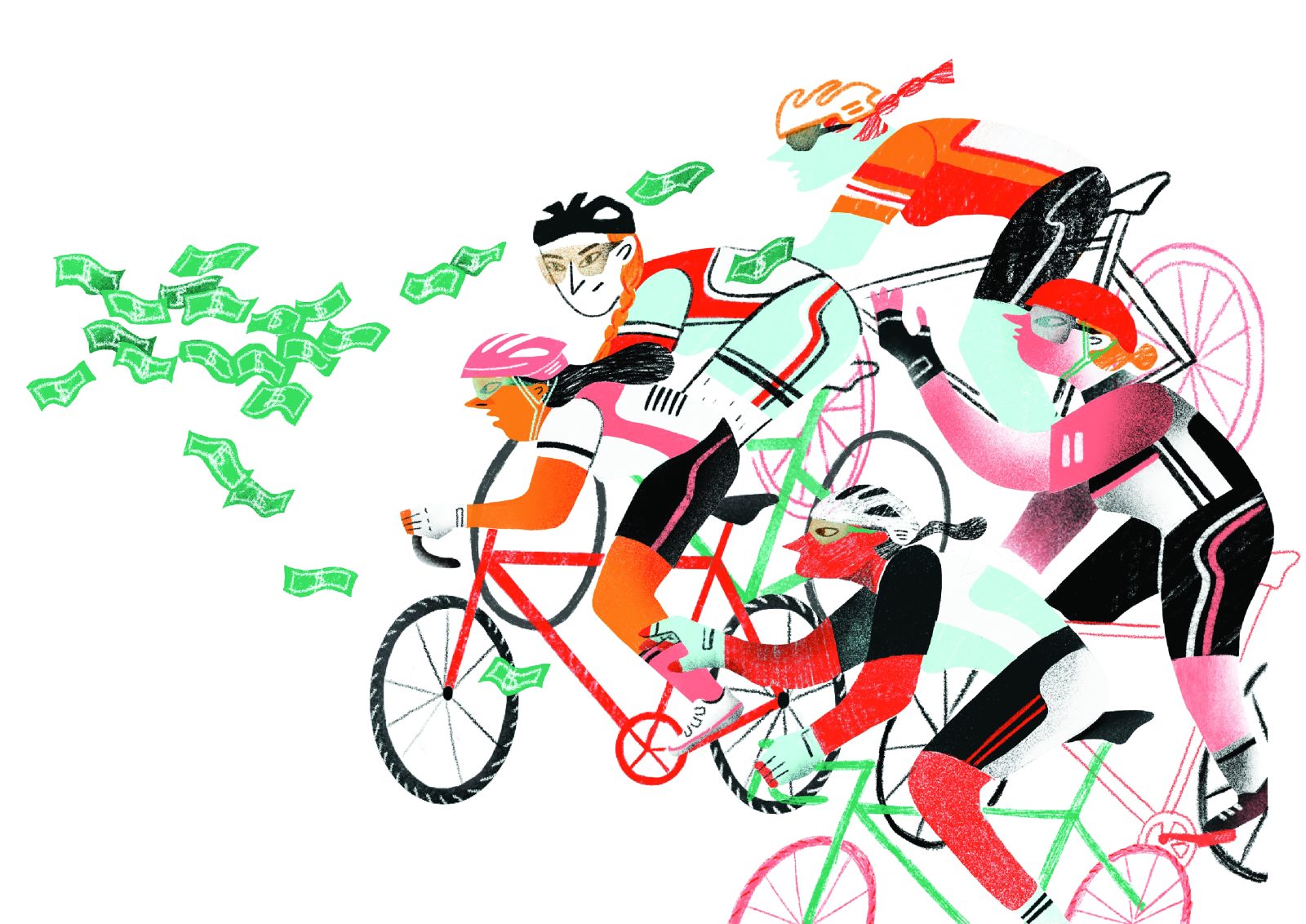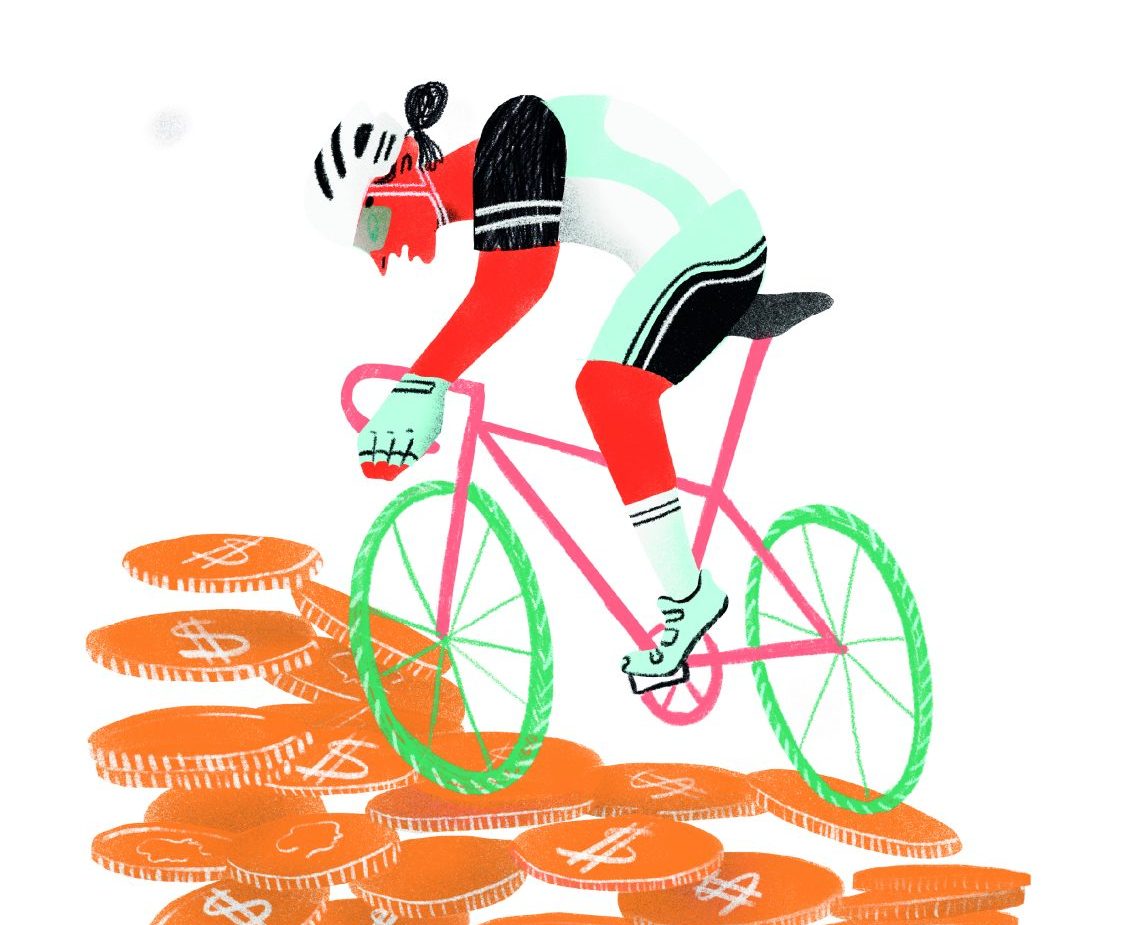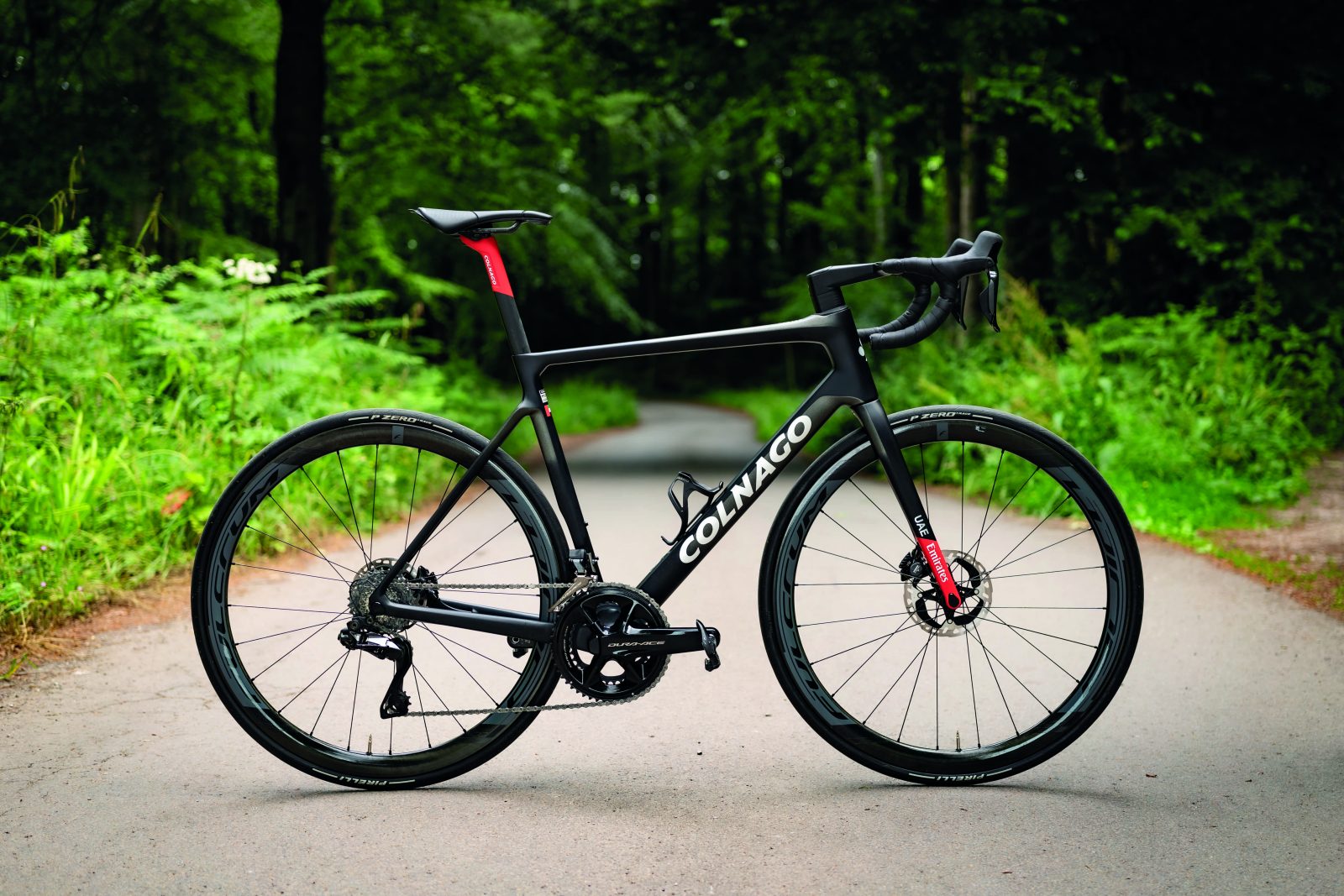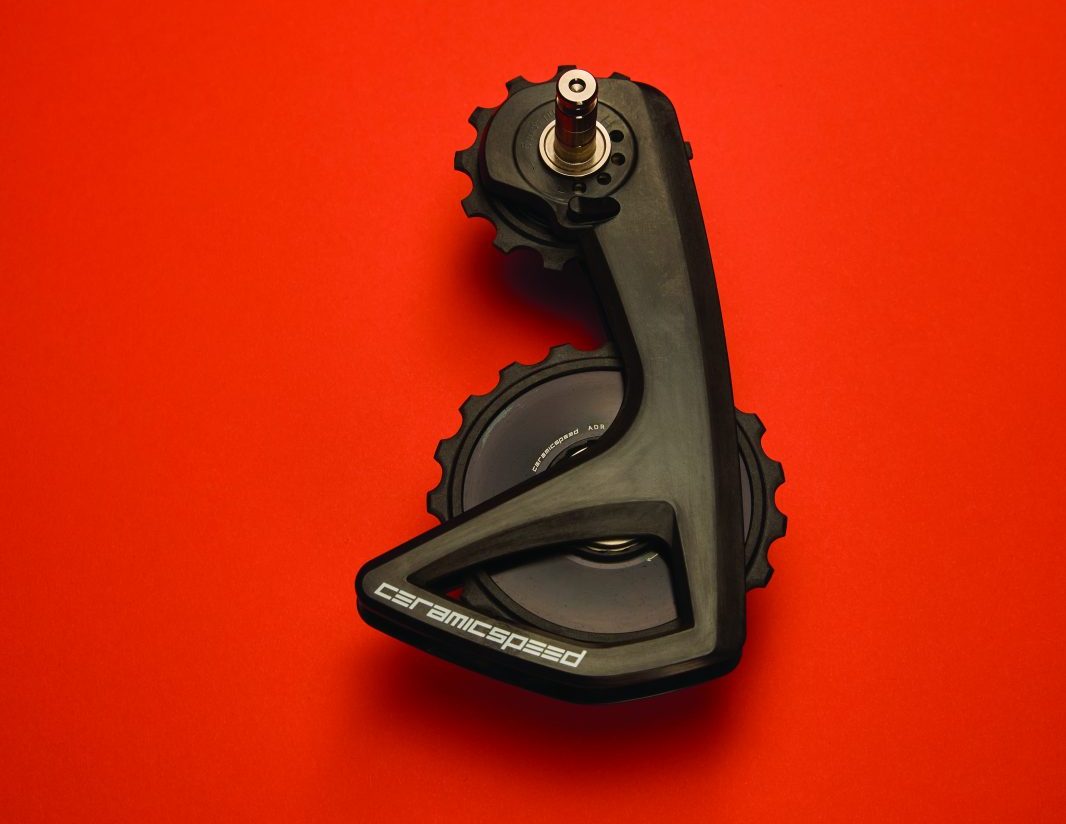Women’s pro cycling is booming, so why are races and teams collapsing for lack of financial support? Cyclist investigates

Words EMMA MAGNUS Illustration JESSICA ANTÚNEZ
Australian cyclist Matilda Raynolds was out for dinner in Brussels when she received a text message.
The Lotto Belgium Tour, a five-day race featuring some of the country’s most iconic climbs, was cancelled due to ‘unforeseen challenges’ that affected the race budget and riders’ safety.
It was due to start in four days’ time. ‘It was a huge shock,’ says Raynolds. ‘It marked the end of my trip.’ Raynolds, 35, had made the 16,300km journey from Australia at her own expense to ride for a local team, Keukens Brabant.
As with every rider among the 23 teams signed up, Raynolds had her own ambitions for the race. It was an opportunity to prove herself on a parcours – full of short, punchy climbs – that suited her, in a televised race.
Above all, it was a chance to sign with a professional team. ‘Most of my races in 2023 were in training for the Belgium Tour, my key goal. It was my best opportunity to get some results,’ says Raynolds, who had turned down openings with other teams to spend eight weeks in Belgium.
‘That’s cycling. It’s such a beautiful, fucked sport. When it’s good, it’s so good. And when it’s bad, it’s so bad.’
The Lotto Belgium Tour, set to take place in June, was not the only women’s race to be cancelled last season, nor was Raynolds the only cyclist to have her European hopes dashed (Raynolds has since signed with Australian super team, Team BridgeLane, for 2024).
A week later, the Tour Féminin des Pyrénées was curtailed, with riders dodging oncoming traffic, parked vehicles and pedestrians, and the race deemed too dangerous to continue.
And in March, The Women’s Tour – the UK’s biggest women’s bike race – was cancelled. It was also scheduled for June.
‘Of course the riders were disappointed,’ says Bruno Savona, sponsorship manager for Lidl-Trek, which won the race with Elisa Longo-Borghini in 2022.
‘It’s not good for riders to endure this. It’s not good for anyone.’
Despite the growing popularity of women’s bike racing – Eurosport recorded nearly 15 million viewers for last year’s Tour de France Femmes, a rise of 7.14% on 2022 – the sport is still embroiled in a perennial struggle for funding.
As well as race cancellations, August saw the longest-running women’s WorldTour team, EF Education-Tibco-SVB, fold as key sponsors pulled out (EF Education-Cannondale has since replaced it). In October, the women’s UCI Gravel World Championships were not broadcast, despite featuring the biggest names in the sport.
Why, when women’s cycling is more popular than ever, is it so hard for it to find funding?
Money’s too tight to mention
‘The business model in cycling is 100% based on sponsorship,’ says Savona. ‘In soccer, you have at least two other sources of revenue: media rights and stadium income.
In cycling, you only have sponsors.’ With the Women’s Tour and Tour of Britain, 65-70% is funded by local authorities, with the remainder from commercial sponsorship, explains Peter Hodges at SweetSpot, the races’ organiser.
Sponsors can contribute in different ways, from providing money in exchange for the title of a team or race, or supplying equipment such as bikes or hospitality.
For brands, cycling sponsorship is a chance to reach specific audiences, as well as gainingcompetitive financial returns. Despite its more limited cashflow, cycling is not a cheap sport to run or participate in.

It costs ‘in the low millions’ to hold both the men’s and women’s races each year, says Hodges, with most going on safety. The policing bill for the men’s race alone is more than $560,000.
Accommodation and TV production costs (footed by SweetSpot) are also significant. For Lidl-Trek, running both WorldTour teams costs between $25 and $75 million, says Savona. Crucially, costs across the board are increasing, which in part has led to race cancellations.
SweetSpot estimates race running costs have risen by at least 20% since 2019. ‘It’s huge,’ says Hodges. ‘I can’t think of many areas where costs haven’t gone up.’
This year, SweetSpot’s 11-year partnership with Škoda also came to an end, putting the company in need of a new big-ticket sponsor at a time when marketing budgets had been cut.
To cover the shortfall, they needed sponsors to invest more money, or they needed more sponsors. ‘It was a combination of the lack of sponsorship income matched with local authority funding being harder than ever to get,’ Hodges says. ‘It was a reduction in funding that couldn’t be bridged before we ran out of time.’
The men’s race, won by Wout van Aert, went ahead in September. Why did that go ahead but not the Women’s Tour? ‘We were up against a hard deadline,’ says Hodges.
‘If the men’s tour had been in June and the women’s in September, it would probably have been a different story.’ Ironically, race cancellations – themselves the result of underfunding – are a deterrent for potential sponsorship.
‘It makes sponsors hesitant if the infrastructure of the sport isn’t secure,’ says Malph Mimms, founder of Strive Consultancy, which advises brands on sponsorship.
‘You don’t want to lose your investment if a team or a race gets wound up and it doesn’t have the funding. That’s also a challenge because they’re underfunded.’
Certainly, for Brother, the Manchester-based printer company that has sponsored both the Women’s Tour and Tour of Britain since 2014, the race’s collapse had a ripple effect.
Without television, social media coverage or access to teams, ‘you’re looking at a potential loss’, says managing director Phil Jones.
‘I 100% understand why SweetSpot had to make that decision but clearly, if you’re a sponsor, there is some impact.’
Brother has invested ‘well over seven figures’ in cycling since 2014, and currently sponsors two women’s teams in addition to the races.
After sponsoring F1 and, famously, Manchester City, cycling represented better value for money, both in terms of ‘advertising value equivalent’ (the amount of time its logo was on TV), lower activation costs and the all-important financial return.
‘Sometimes with return on investment, you’re looking at a multiplier of three or five, but mine is in the twenties and thirties,’ says Jones.
‘That figure has been going up the longer we’ve been doing it.’ Today, Jones says most of his investment – roughly 64% – is skewed towards women’s cycling.
Jumbo-Visma’s Anna Henderson, he explains with pride, came up through a Brother-sponsored team.
‘The number of teams available in men’s racing had begun to decline, whereas there were more women’s teams being created. The cost of entry in the women’s race scene was lower. It represented good value for money and aligned very well with who we are as a company.’
Savona also highlights the lucrative profit margins that can be found in women’s cycling: ‘They can give impressive returns to sponsors.’
Since the creation of their women’s team in 2019, Lidl-Trek have employed the same funding strategy for both teams, with the same base salary for male and female riders.
‘We present our men’s and women’s team [to sponsors] as one. To do that, we need the same people to support them and the same sponsors,’ says Savona.
This year, Lidl replaced Segafredo as the team’s title sponsor, boosting its finances by between 35% and 55%. It has allowed the team to widen their ambitions, says Savona. ‘We want to become number one, for both men’s and women’s.
That’s our goal.’ Some brands, Lidl-Trek and SweetSpot have found, are only interested in sponsoring one component. More commonly, this is the men’s.
‘It’s mainly because of exposure and team reputation, and also the possibility of involving big-name athletes in their marketing,’ says Savona.
But even with sponsors on board, there are still subtle differences in expectations. For women’s teams there is a greater focus on individual star riders, whereas for men, the emphasis is more on the team. ‘It’s a question of visibility,’ he says.
‘Women’s cycling is in a different part of its development. If the audience of a race is not as high, sometimes you have to rely on the popularity of a single rider.’
Does this put more pressure on star female riders?
‘Yes,’ says Savona. ‘That’s for sure.’
The gender gap
Women’s cycling may offer potentially lucrative returns, and organisations like Lidl-Trek and SweetSpot may be championing their women’s offerings, but budgets for women’s cycling remain lower.
The Women’s Tour has around 65% of the budget of the men’s, mainly, says Hodges, because the women’s race is shorter.
Lidl-Trek’s men’s and women’s budgets are also ‘considerably different’, largely due to the women’s smaller racing calendar.
Women can expect lower prize money – the pot for this year’s Paris-Roubaix Femmes, for example, was almost half of the men’s – and lower salaries, despite the introduction of a €32,102 (about $52,000) minimum wage.
For riders like Raynolds, these disparities are difficult to ignore. ‘It certainly makes itself obvious in little ways. It may be that the male athlete has a better groupset or bike,’ she says.
‘There is still a discrepancy in the investment – there is so much more money within the male peloton. I think that’s a bit of a legacy. On the road scene, it’s things like safety, it’s the care of the organisers. When there’s not enough live coverage, that’s where it shows itself the most.’
For Raynolds, cycling would not be possible without full-time work. She works for clothing brand Black Sheep Cycling, and had previously secured supplier sponsorships from Specialized, 100%, Sram and Wahoo (although these will no doubt alter following the BridgeLane contract).
Cycling is an expensive career choice, and the instability of the racing calendar and lack of coverage only makes it harder to pursue.
‘It’s very difficult, unless it’s funded by the bank of mum and dad, or unless you’re on a paying team,’ she says.
‘I’d hate to know the amount of money I’ve spent – it’s certainly a depreciating asset.’ Cycling’s gender funding gap is what Jones at Brother calls a ‘wicked problem’, where ‘there are so many contributory factors that there’s not one lever that fixes it’.
There is the legacy of underinvestment, which has given men’s cycling a significant head start in terms of building audiences and resources.
Without a history of big-name sponsorship, says Mimms, ‘it makes it hard to invest in women’s cycling. Whatever brands say, they take comfort in whatever their competitors are doing.’

There is the fact that audiences for women’s races are still smaller.
Then there’s the challenges of the current economic climate; the instability of the women’s racing calendar; shorter races; short-term sponsorship contracts; the lack of coverage.
‘When it comes to the advancement of women’s cycling and the growth in sponsorship, all of that comes down to ensuring there is coverage,’ says Raynolds.
‘Nothing grows, nothing happens, without people knowing about it.’
The power of stories
The sponsorship model itself is unstable. Even Jumbo-Visma, whose men’s team won all three Grand Tours in2023, spent months urgently searching for a title sponsor to replace the departing Jumbo.
‘It’s shown how precarious our sport is – we’re at the mercy of these commercial brands that sponsor us, and that rug can be ripped out from underneath riders very quickly,’ says Raynolds.
But if a lack of investment is both the problem and the solution, what’s the answer? ‘Women’s cycling – however it happens – needs storytelling,’ says Mimms.
‘Sponsorship is about connecting to fans in a meaningful way, via a platform, to change an attitude or behaviour.’
TV programmes such as Welcome to Wrexham and Netflix’s Drive to Survive and Tour de France Unchained have had a transformative impact on their sports’ fan numbers.
And women’s cycling, without the darker doping history, represents a ‘clean brand’ with a story to tell. ‘Women’s cycling needs its own FIFA football game, its own Welcome to Wrexham.
If people can see that there’s attention and interest, they’re willing to place bets by putting money in there. That helps grow the sport.’
Raynolds agrees: ‘You’ve got some fantastic personalities in women’s cycling. You think of Cecilie Uttrup Ludwig, of Alison Jackson… it’s a really exciting time for investment in women’s cycling.’
Yet, without a high-budget production or Tour de France Unchained for the women (a second season is on the way for the men’s), much of the onus is seemingly still on female cyclists to tell their stories themselves – for Uttrup Ludwig to deliver energetic post-race interviews, Jackson to draw in audiences on TikTok, or for Demi Vollering to film herself cycling with her dog in her backpack.
‘Female athletes are so aware of their responsibilities in promoting their brand, of putting on entertaining cycling, because if they don’t, people will get bored,’ says Raynolds.
‘Men have never really had to take on that burden.’ Women’s cycling has all the elements of a good story: strong characters, fierce rivalries, a struggle in the face of adversity.
But like Great Expectations, it could do with a munificent benefactor and, above all, a happy ending.
What are you waiting for, Netflix?
Emma Magnus is a freelance writer who is yet to receive any offers for her own Netflix special


